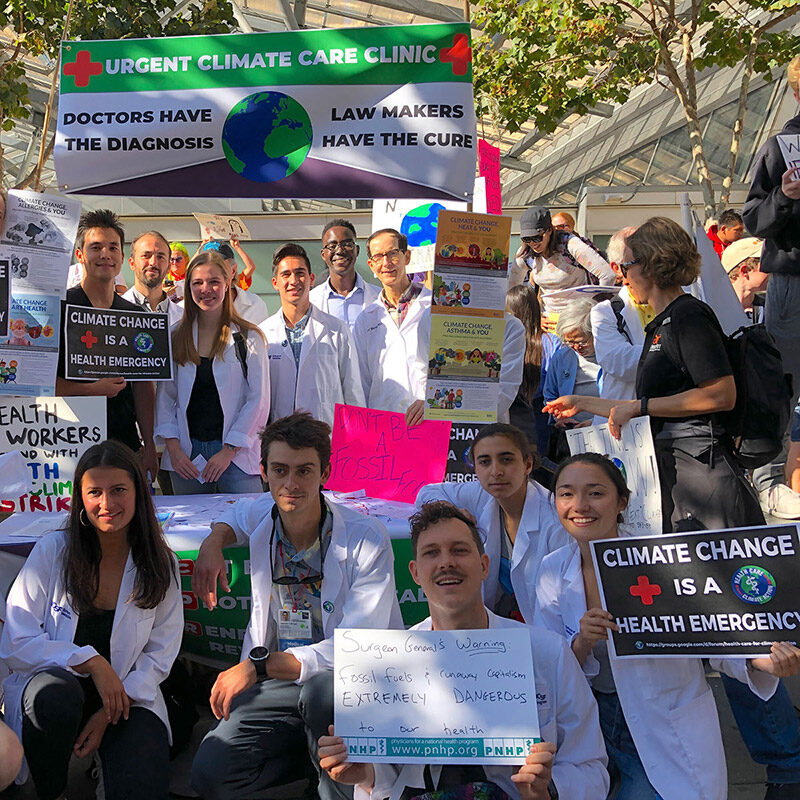
Letter from
the President
Since our university was founded more than 150 years ago, we have generated essential new knowledge and solutions to our society’s most complex problems. 2020 presented an unprecedented number of challenges at once — including a global pandemic that has infected more than 60 million people, a nationwide reckoning on systemic racism and injustice, and the ongoing existential threat of climate change.
In this perilous moment, I am proud that UC has continued to make steady progress toward our ambitious sustainability goals. From surpassing our sustainable food service target, to increasing our use of carbon-free electricity, and beginning to phase out single-use plastics, we have never wavered in our commitment to build a more sustainable university, and a more sustainable future.
Right now, many governments and other institutions are stretched to the limit by multiple crises competing for attention and resources. Some leaders have been pressured to roll back their sustainability commitments and shift their focus elsewhere. But as we continue to confront extreme drought and flooding, rampaging wildfires, and rising sea levels, this is not the time to shrink from our collective responsibility to tackle the climate crisis. On the contrary, the events of this year have shown just how important it is for elected leaders and institutions around the world to work collectively to address challenges that affect all of us.
Looking ahead, UC will continue to do everything we can to lead the way toward a cleaner, more resilient and more equitable future for all. I look forward to continuing to partner with the UC community on this journey.

Michael V. Drake, MD
President, University of California

Letter from the
AVP of Energy & Sustainability
The theme for this year’s Annual Sustainability Report is Resilience: From Coronavirus to Climate Change. Resilience is defined as “the ability of a system or community to survive disruption and to anticipate, adapt and flourish in the face of change” by Second Nature, which coordinates the University Climate Change Coalition (UC3), a network of 22 leading North American research universities — including the University of California — that are working together to accelerate local and regional climate action.
In 2020, we were tested by massive changes, starting in March, when our campuses moved online to mitigate community spread of COVID-19. At the same time, our medical centers had to quickly transform their operations to prepare for coronavirus patients and protect our health care workers. The late spring brought widespread protests over systemic racism, and the UC community entered a period of self-reflection to assess how we can improve as an anti-racist institution. California’s challenges continued through the summer, with record-breaking 130° temperatures in Death Valley, power outages, widespread lightning-ignited wildfires and hazardous air quality due to smoke and ash. Fires forced the complete shutdown of UC Santa Cruz and evacuations from several other UC campuses. Blazes consumed nine buildings and an untold number of acres of grassland, forest, chaparral and other natural habitats in UC’s prized natural reserves. Looking back on 2020, it’s clear that UC has done a remarkable job in adapting to these disruptions, but our goal to flourish in the face of these changes remains a work in progress.
UC’s sustainability goals are meant to help us mitigate future disruptions and improve our resilience. This year’s report includes a focus on how our sustainability efforts have contributed to resilience in operations, within local communities, with student and staff populations, and in research.
We are excited to present this year’s report as an interactive website for the first time, which we hope will reach a broader audience and allow people to dive more deeply into our sustainability data.
Thank you for reading,

David Phillips
Associate Vice President, Energy and Sustainability
UC Office of the President
Policy Areas
The University of California’s sustainability commitment began in 2003 with a Regental action that led to the adoption of the Presidential Policy on Green Building Design and Clean Energy Standards in 2004. Since adopting that policy, UC has expanded the scope of the Sustainable Practices Policy to include climate protection, transportation, sustainable building operations, zero waste, procurement, food, water and health care facilities.

The Sustainable Practices Policy includes all 10 campuses, six academic health centers, UC Agriculture and Natural Resources, Lawrence Berkeley National Laboratory and the UC Office of the President.
The UC Sustainable Practices Policy can be accessed online, and a summary is available below. UC’s Sustainability Data summarizes progress toward the goals.
Climate
- Reduce greenhouse gas emissions to year 1990 levels by 2020.
- Achieve climate neutrality for scope 1 and 2 sources by 2025.
- Achieve climate neutrality from specific scope 3 sources (as defined by Second Nature’s Climate Commitment) by 2050 or sooner.
Energy
- Energy efficiency: Reduce each location’s energy use intensity by an average of at least 2% annually.
- Clean electricity: By 2025, each campus and health location will obtain 100% clean electricity. By 2018, the University’s Clean Power Program will provide 100% clean electricity to participating locations.
- On-campus combustion: By 2025, at least 40% of the natural gas combusted on-site at each campus and health location will be biogas.
Food Service
- By 2030, campus food service will procure 25% sustainable food as defined by the Association for the Advancement of Sustainability in Higher Education’s Sustainability Tracking, Assessment and Rating System (AASHE STARS), and health system food service will procure 30% sustainable food as defined by Practice Greenhealth.
- Develop a plant-forward menu goal.
Green Building
New Buildings and Renovations
- Design and construct all new buildings and major renovations to a minimum LEED-NC (new construction) Silver rating as well as meet the prerequisites of the Laboratories for the 21st Century Environmental Performance Criteria.
- Design and construct all renovation projects with a cost of $5 million or greater (except acute care facilities) to a minimum LEED-CI (commercial interiors) certified rating.
- Energy-efficient design:
- Acute care/hospital facilities and medical office buildings: outperform ASHRAE (the American Society of Heating, Refrigerating and Air-Conditioning Engineers) standard 90.1-2010 by at least 30% or meet UC’s whole-building energy performance targets.
- All other buildings: outperform the energy requirements of the California Building Code by at least 20% on all new construction and major renovation projects or meet UC’s whole-building energy targets.
- No new building or major renovation approved after June 30, 2019, shall use on-site fossil fuel combustion (e.g., natural gas) for space and water heating (except those projects connected to an existing campus central thermal infrastructure).
Existing Building Operations and Maintenance (EBOM)
- Each campus will submit for certification one pilot building at a LEED-EBOM certified level or higher.
- Each campus shall seek to certify as many buildings as possible through the LEED-EBOM rating system.
General Sustainability Performance Assessment
All undergraduate campuses must achieve an Association for the Advancement of Sustainability in Higher Education’s Sustainability Tracking, Assessment and Rating System’s (AASHE STARS) Silver rating and strive for Gold by 2023.
Procurement
- 100% compliance with required level green spend criteria within three fiscal years of the addition of those products and/or categories to the Sustainable Procurement Guidelines.
- 25% green spend as a total percentage of spend per product category; target to be reached within three fiscal years after a category is added to the guidelines.
- 25% economically and socially responsible spend as a total percentage of addressable spend; target to be reached within five fiscal years of adoption of this section in the guidelines.
- Allocation of a minimum of 15% of the points utilized in solicitation evaluations to sustainability criteria.
Sustainable Building Operations and Labs
- Campuses will implement an ongoing Green Lab assessment program and assess three research groups.
- Campuses will identify existing single-pass cooling systems and constant-flow sterilizers and autoclaves in laboratories and develop a plan for replacement.
Transportation
Fleet
- By 2025, zero-emission vehicles (ZEV) or hybrid vehicles shall account for at least 50% of all new light-duty vehicle acquisitions.

Commute
- By 2025, each location shall strive to reduce its percentage of employees and students commuting by single-occupancy vehicles (SOV) by 10% relative to its 2015 SOV commute rates.
- By 2050, each location shall strive to have no more than 40% of its employees and no more than 30% of all employees and students commuting to the location by SOV.
- By 2025, each location shall strive to have at least 4.5% of commuter vehicles be ZEV.
- By 2050, each location shall strive to have at least 30% of commuter vehicles be ZEV.
UC Health
- By 2025, each health system will obtain 100% clean electricity.
- Each health system will adopt energy performance targets for acute care centers and medical office buildings.
- All health systems will be members of Practice Greenhealth, a nonprofit dedicated to health care sustainability, and submit annual sustainability data for awards.
- Each health system will have waste and water goals that align with Practice Greenhealth’s reporting requirements.
- Each health system will procure 30% sustainable food as defined by Practice Greenhealth.
Water
- Campuses will reduce growth-adjusted potable water consumption by 20% by 2020 and 36% by 2025, when compared to a three-year average baseline of fiscal year 2005-06, fiscal year 2006-07 and fiscal year 2007-08.
Zero Waste
- Campuses will achieve zero waste (defined as 90% diversion from landfill).
- Campuses will reduce per capita municipal solid waste generation to 25% below fiscal year 2015-16 levels by 2025, and 50% below fiscal year 2015-16 levels by 2030.
- The University is committed to the reduction and elimination of single-use items such as plastic bags, single-use plastic foodware accessory items and single-use plastic beverage bottles.
- By 2020, the University will prohibit the sale, procurement and distribution of packaging foam.
Timeline of Sustainability
For many decades, the University of California has been committed to sustainability in its operations.
1970-99
1970
- UC Santa Barbara creates Environmental Studies Program
1971
- UC Santa Cruz establishes Student Farm
1977
- UC Davis Student Farm opens
1998
- UC issues policy on Trademark Licensing Code of Conduct providing guidance to companies granted permission to use the University’s name on how workers should be treated
1999
- UC Santa Barbara students approve student fee to create Coastal Fund
2000-09
2002
- UC’s first LEED certification, UC Santa Barbara’s Bren School, is also the first LEED Platinum laboratory building in the world
2004
- California Student Sustainability Coalition launches Education for Sustainable Living Program
- President Dynes issues policy on Green Building Design and Clean Energy Standards
2006
- The Green Initiative Fund referendum passes at UC Santa Barbara
- UC amends Sustainable Practices Policy to include transportation, building renovation, operations, waste management and procurement
2007
- All 10 UC chancellors sign the American College and University Presidents’ Climate Commitment
2009
- Sustainable food service section added to Sustainable Practices Policy
2010-19
2012
- Goal of installing 10 MW of on-campus renewable energy met two years early
- 100th LEED certification
2013
- President Napolitano announces the Carbon Neutrality Initiative, committing UC to carbon neutrality by 2025
2014
- President Napolitano announces the Global Food Initiative
- UC becomes the first university in the world to sign the United Nations Principles for Responsible Investing
2015
- Bending the Curve Carbon Neutrality Research Summit
- UC commits to invest $1 billion in clean and renewable energy over five years
- UC publishes Framework for Sustainable Investing
- UC sells companies with major revenue from tar sands or thermal coal
2016
- UC signs on to Task Force on Climate-Related Financial Disclosures (TCFD)
- UC begins documenting annual carbon footprint of public equities holdings
2017
- Largest solar purchase by any U.S. university (80 MW) comes online

2018
- UC Health sustainability section added to Sustainable Practices Policy
- 300th LEED certification
- UC Regents vote to make Environmental, Social and Corporate Governance (ESG) part of the UC Investment Policy
2019
- UC’s internal power company is carbon neutral
- UC General Endowment Pool sells investments in companies that own fossil fuel reserves
- UC signs climate emergency letter ahead of the U.N. Global Climate Summit
- UC recognized as the top college/university in the U.S. EPA’s Green Power Partnership rankings
- UC joins Climate Action 100+
2020-50
2020
- $1 billion committed to clean energy investments
- Carbon emissions footprint of UC’s public equities investment portfolio shrunk by 44%
- UC pension and working capital sell investments in companies that own fossil fuel reserves
- UC Health recognized as a Climate Champion in the Health Care Climate Challenge
- UC Merced becomes the first public research university in the country to achieve carbon neutrality
- 20% sustainable food procurement goal met systemwide
- Over 300 research labs assessed as green
- Policy adopted to phase out single-use plastics

2025
- Carbon neutrality goal (scopes 1 and 2) to be met
- Campuses to reduce potable water use per capita by 36%
2030
- 25% sustainable food procurement goal for campuses and 30% sustainable food procurement goal for health systems
2050
- Carbon neutrality goal (scope 3) to be met
 Sustainability Annual Report 2020
Sustainability Annual Report 2020